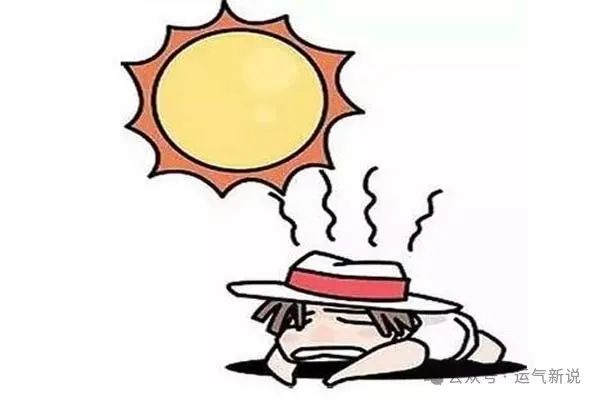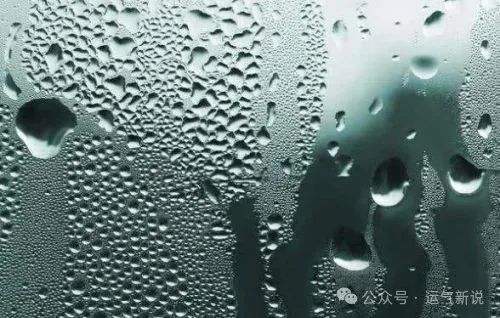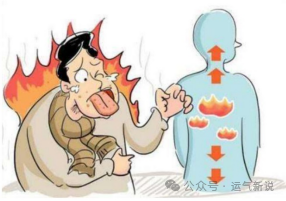The Essence and Characteristics of the Six Excesses in Qi Movement When Qi circulates without bias, it rises and falls, entering and exiting like an endless loop. The five movements alternate, corresponding to celestial cycles, while the six Qi are divided and governed according to seasonal changes, creating a continuous cycle of generation and transformation. This is the norm. However, when Qi movement is abnormal, there will be changes of excess and deficiency. The essence of the “Six Excesses” and their corresponding characteristics can be summarized from the perspectives of excess and deficiency as follows: Wind
Wind

 Wind represents the Wood element, symbolizing the rising and reaching of Qi. When the wind Qi is excessive, it indicates an overabundance of the dispersing power of Qi movement, causing unrest in nature and in people, leading to increased activity and irritability. Conversely, when wind Qi is deficient, the dispersing power of Qi movement is insufficient, resulting in stagnation and weakness in nature and in people, leading to depression and discomfort, and potentially causing changes.
Wind represents the Wood element, symbolizing the rising and reaching of Qi. When the wind Qi is excessive, it indicates an overabundance of the dispersing power of Qi movement, causing unrest in nature and in people, leading to increased activity and irritability. Conversely, when wind Qi is deficient, the dispersing power of Qi movement is insufficient, resulting in stagnation and weakness in nature and in people, leading to depression and discomfort, and potentially causing changes. Fire
Fire

 Fire represents the upward and floating nature of Qi. When fire Qi is excessive, it indicates an overabundance of rising Qi, leading to heat and dryness in nature, causing plants to wither and people to exhibit excessive energy and restlessness. When fire Qi is deficient, the power of Qi to flourish is insufficient, resulting in coldness and weakness in nature, leading to poor growth and symptoms such as cold limbs and abdominal distension in people.
Fire represents the upward and floating nature of Qi. When fire Qi is excessive, it indicates an overabundance of rising Qi, leading to heat and dryness in nature, causing plants to wither and people to exhibit excessive energy and restlessness. When fire Qi is deficient, the power of Qi to flourish is insufficient, resulting in coldness and weakness in nature, leading to poor growth and symptoms such as cold limbs and abdominal distension in people. Summer Heat
Summer Heat

 Summer heat represents the floating and abundant nature of Qi. When summer heat Qi is excessive, it indicates a dispersing and uncontained Qi movement, leading to heat and humidity in nature, causing people to experience exhaustion and heat-related illnesses. When summer heat Qi is deficient, the power of Qi to rise and flourish is insufficient, leading to poor growth and vitality in nature, and symptoms of fatigue in people.
Summer heat represents the floating and abundant nature of Qi. When summer heat Qi is excessive, it indicates a dispersing and uncontained Qi movement, leading to heat and humidity in nature, causing people to experience exhaustion and heat-related illnesses. When summer heat Qi is deficient, the power of Qi to rise and flourish is insufficient, leading to poor growth and vitality in nature, and symptoms of fatigue in people. Humidity
Humidity

 Humidity represents the Earth element, symbolizing the convergence of Qi. When humidity Qi is excessive, it indicates stagnation and fullness in Qi movement, leading to dampness and heaviness in nature, causing symptoms such as bloating and fatigue in people. When humidity Qi is deficient, the convergence of Qi is insufficient, leading to poor growth and vitality in nature, and symptoms of digestive issues in people.
Humidity represents the Earth element, symbolizing the convergence of Qi. When humidity Qi is excessive, it indicates stagnation and fullness in Qi movement, leading to dampness and heaviness in nature, causing symptoms such as bloating and fatigue in people. When humidity Qi is deficient, the convergence of Qi is insufficient, leading to poor growth and vitality in nature, and symptoms of digestive issues in people. Dryness
Dryness

 Dryness represents the Metal element, symbolizing the descending and consolidating nature of Qi. When dryness Qi is excessive, it indicates an overabundance of consolidating Qi movement, leading to dryness and weakness in nature, causing symptoms such as cough and chest tightness in people. When dryness Qi is deficient, the consolidating power of Qi is insufficient, leading to excessive growth and vitality in nature, and symptoms of excessive sweating and heat in people.
Dryness represents the Metal element, symbolizing the descending and consolidating nature of Qi. When dryness Qi is excessive, it indicates an overabundance of consolidating Qi movement, leading to dryness and weakness in nature, causing symptoms such as cough and chest tightness in people. When dryness Qi is deficient, the consolidating power of Qi is insufficient, leading to excessive growth and vitality in nature, and symptoms of excessive sweating and heat in people. Cold
Cold

 Cold represents the Water element, symbolizing the closing and storing nature of Qi. When cold Qi is excessive, it indicates an overabundance of closing Qi movement, leading to coldness and stagnation in nature, causing symptoms such as cold limbs and kidney deficiency in people. When cold Qi is deficient, the closing power of Qi is insufficient, leading to excessive heat and rain in nature, and symptoms of weakness in people.
Cold represents the Water element, symbolizing the closing and storing nature of Qi. When cold Qi is excessive, it indicates an overabundance of closing Qi movement, leading to coldness and stagnation in nature, causing symptoms such as cold limbs and kidney deficiency in people. When cold Qi is deficient, the closing power of Qi is insufficient, leading to excessive heat and rain in nature, and symptoms of weakness in people. Conclusion
Conclusion

The above discusses the changes of excess and deficiency in the “Six Qi”, which is the essence and characteristic of the “Six Excesses”. The related properties of the “Six Excesses” and their corresponding pathogenic characteristics will be inferred mainly from this.
Source: Sun Zhiqi. Discussion on the Essence of the “Six Excesses” Based on the Theory of Qi Monism [D]. Shandong University of Traditional Chinese Medicine, 2016.
 END
END
 Follow the New Theory of Qi
Follow the New Theory of Qi

